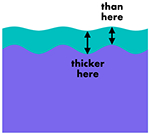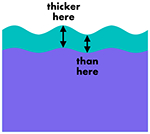TABLE I.
Summary of main predictions for the growth regime (0 < ∊ < 1) of the convex variant, with comparison to the corresponding predictions of a standard morphogenesis model. The ∊ ≪ 1 limit pertains to early development, i.e., just after the onset of shape change. The five dimensionless model parameters discussed above are written in a slightly different (but equivalent) form here in order to emphasize their physical meaning.
| Buckling without bending model | Conventional elastic bilayer model | |
|---|---|---|
| Phase relationship between film thickness and substrate deformation (the planar limit t/r → 0 is shown for simplicity) |  |
 |
| Amplitude of film thickness oscillations | = [(1 − ∊)/∊]×wrinkling amplitude | ≪ wrinkling amplitude |
| Wave number q = (2π〈r〉)/λ | ~(〈r〉/t)(Ef/Es)−1/3 | |
| Near morphogenesis onset, the number of wrinkles q is independent of | Geometry | Differential strain (in excess of critical strain) |
| To generate more wrinkles | Increase growth potential kt or decrease gradient penalty β | Decrease film thickness (relative to system size) or decrease stiffness contrast Ef/Es |
| Proxy for time in developmental dynamics | ∊ (see Ref. [27] for more details) | Differential strain |
| Minimal input physics in the form of dimensionless parameters | (i) Effective radial spring constant kr/μ(= ∊−1) presumably coming from system-spanning radial glia fibers (ii) Growth potential kt/μ of the film (iii) Thickness gradient penalty β/μ presumably coming from film-spanning fibers, e.g., Bergmann glia (iv) Preferred geometry (v) Reference geometry t0/r0 |
(i) Stiffness contrast Ef/Es of two homogeneous elastic materials (ii) Zero-strain geometry (iii) Differential strain eθθ |
